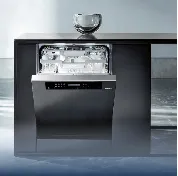
Dishwasher Eco Mode Analysis: Saving Water and Power Without Compromising Cleaning Performance

What Exactly is Dishwasher Eco Mode?
Ever peeked at your dishwasher's control panel and wondered about that mysterious "Eco" button? You're not alone! Eco mode is your dishwasher's sustainability superpower—a specialized setting designed to clean your dishes using significantly less energy and water than regular cycles. Instead of blasting dishes with hot water and quick cycles, eco mode plays the long game. It uses cooler water temperatures (around 110-120°F instead of 130-140°F) and extends washing time to compensate, allowing detergents to work smarter, not harder.
Think of eco mode as the marathon runner of dishwasher cycles—it conserves resources through endurance rather than intensity. Lower water temperature means less electricity needed for heating, while extended cycles maximize cleaning efficiency. Some models even optimize detergent usage to reduce chemical runoff. This combination delivers sparkling dishes while shrinking your environmental footprint.
Why Your Dishes (and Planet) Will Thank You
Planet-Friendly Performance
Using eco mode regularly makes a tangible difference. It slashes energy consumption by 20-50% and reduces water usage by up to 30%. For perspective, a standard cycle uses 4-6 gallons, while eco mode might use just 3-4. Multiply that by weekly loads, and you're saving hundreds of gallons annually—a win for drought-prone areas and water conservation.
Wallet-Friendly Savings
Those resource cuts translate to lower utility bills. An ENERGY STAR® dishwasher in eco mode can save you $40+ annually on electricity and water costs. Plus, cooler temperatures reduce wear on components, extending your appliance's lifespan and delaying costly replacements. In a modern kitchen with waterproof flooring and energy-efficient appliances, the dishwasher's eco mode is a perfect fit.
Surprising Cleaning Perks
Contrary to myth, eco mode doesn't mean spotty results. Longer cycles allow enzymes in detergents to break down food residues thoroughly, while cooler water is gentler on glassware and delicate ceramics. Heavy soils still come clean when dishes are properly loaded—eco mode is more capable than many realize!
Eco Mode vs. Other Cycles: What Works When?
| Cycle Type | Duration | Best For | Energy Use |
|---|---|---|---|
| Eco Mode | 2-4 hours | Daily loads, lightly soiled dishes | Lowest (20-50% less) |
| Standard Wash | 1.5-2.5 hours | Moderate soils, everyday use | Medium |
| Quick Wash | 30-60 minutes | Lightly used glasses, urgent needs | Higher (per minute) |
| Heavy Duty | 2.5-3.5 hours | Pots/pans, baked-on residues | Highest |
Pro tip: Eco mode works best for everyday dishes—plates, bowls, and silverware with typical food residues. Reserve heavy-duty cycles for greasy pans or bakeware. For quick-turnover needs like party glasses, quick wash is ideal but use it sparingly since its efficiency drops with heavier soils.
Getting the Most Out of Your Eco Mode
Loading Hacks
- Pre-rinse minimally : Scrape large chunks, but avoid rinsing—modern enzymes need food residues to activate.
- Zone your dishes : Place heavily soiled items on bottom rack facing spray arms, delicate items on top.
- Prevent "dish crowding" : Leave space between items for water flow.
Detergent & Maintenance
- Use eco-specific detergents—they're formulated for low-temp effectiveness
- Clean filters monthly to maintain water pressure
- Run a monthly cleaning cycle with vinegar or dishwasher cleaner
Remember: Eco mode isn't "set and forget." Loading efficiently boosts performance. Position dishes at angles so water hits concave surfaces, nest silverware handles-down for better cleaning, and ensure spray arms rotate freely before starting.
Busting Eco Mode Myths
Myth: "Eco Mode Doesn't Clean Well"
Reality: With quality detergent and proper loading, eco mode matches standard cycles for cleaning power. The extended time lets detergents work optimally at lower temps.
Myth: "It's Only for Lightly Dirty Dishes"
Reality: Tests show eco mode handles moderate-to-heavy soils! It struggles only with dried-on or baked residues, which require specialized cycles.
Where Eco Mode Tech is Headed
The future looks bright for eco dishwashing:
- Smart sensors will automatically adjust water and cycle length based on soil levels
- Heat exchangers will reuse thermal energy from previous cycles
- Water recycling systems will further reduce consumption
- AI optimization will learn household patterns to run at off-peak energy times
Manufacturers are increasingly using recycled materials in manufacturing and packaging to complement eco mode's sustainability.
Tags:
Recommend Products











